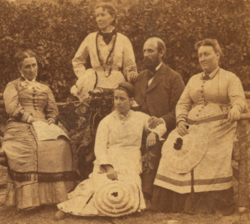 | |
| Long title | A bill to punish and prevent the Practice of Polygamy in the Territories of the United States and other Places, and disapproving and annulling certain Acts of the Legislative Assembly of the Territory of Utah. |
|---|---|
| Nicknames | Morrill Anti-Bigamy Act of 1862 |
| Enacted by | the 37th United States Congress |
| Effective | July 1, 1862 |
| Citations | |
| Public law | Pub. L. 37–126 |
| Statutes at Large | 12 Stat. 501 |
| Legislative history | |
| |
| Mormonism and polygamy |
|---|
 |
|
|
The Morrill Anti-Bigamy Act (37th United States Congress, Sess. 2., ch. 126, 12 Stat. 501) was a federal enactment of the United States Congress that was signed into law on July 1, 1862, by President Abraham Lincoln. Sponsored by Justin Smith Morrill of Vermont, the act banned bigamy in federal territories such as Utah and limited church and non-profit ownership in any territory of the United States to $50,000.[1]
The act targeted the Mormon practice of plural marriage and the property dominance of the Church of Jesus Christ of Latter-day Saints (LDS Church) in the Utah Territory. The measure had no funds allocated for enforcement, and Lincoln chose not to enforce this law; instead Lincoln gave Brigham Young tacit permission to ignore the Morrill Act in exchange for not becoming involved with the Civil War.[2] General Patrick Edward Connor, commanding officer of the federal forces garrisoned at Fort Douglas, Utah beginning in 1862, was explicitly instructed not to confront the Mormons over this or any other issue.[2]
The Morrill Anti-Bigamy Act was amended in 1882 by the Edmunds Act, and then again in 1887 by the Edmunds–Tucker Act.
- ^ Statutes at Large, 37th Congress, 2nd Session, page 501. A Century of Lawmaking for a New Nation: US Congressional Documents and Debates, 1774–1875. The Library of Congress. Accessed 18 May 2006.
- ^ a b Firmage, Edwin Brown; Mangrum, Richard Collin (2001), Zion in the courts, University of Illinois Press, p. 139, ISBN 0-252-06980-3,
Having signed the Morrill Act, Lincoln reportedly compared the Mormon Church to a log he had encountered as a farmer that was "too hard to split, too wet to burn and too heavy to move, so we plow around it. That's what I intend to do with the Mormons. You go back and tell Brigham Young that if he will let me alone, I will let him alone."